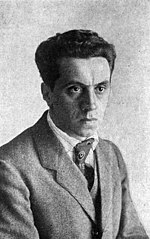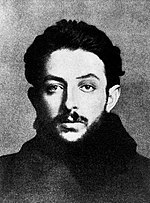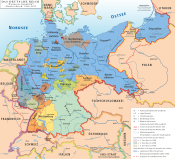Bavarian Soviet Republic
Bavarian Soviet Republic Münchner Räterepublik | |||||||||||||
|---|---|---|---|---|---|---|---|---|---|---|---|---|---|
| 1919 | |||||||||||||
|
Soviet republic | |||||||||||||
• 6 April 1919 - 12 April 1919 | Ernst Toller | ||||||||||||
• 12 April 1919 – 3 May 1919 | Eugen Leviné | ||||||||||||
| Historical era | Interwar period · Revolutions of 1917–1923 · Political violence in Germany (1918–1933) | ||||||||||||
• Established | 6 April 1919 | ||||||||||||
• Disestablished | 3 May 1919 | ||||||||||||
| Currency | German Papiermark (ℳ) | ||||||||||||
| |||||||||||||
| Today part of | Germany | ||||||||||||
The Bavarian Soviet Republic, or Munich Soviet Republic (
Background
The roots of the republic lay in the
Though he advocated a
After Eisner's assassination, the Landtag convened, and Erhard Auer – the leader of the Social Democrats and the Minister of the Interior in Eisner's government – began to eulogize Eisner, but rumours had already begun to spread that Auer was behind the assassination. Acting on these false allegations, Alois Linder, a saloon waiter who was a fervent supporter of Eisner, shot Auer twice with a rifle, seriously wounding him. This prompted other armed supporters of Eisner to open fire, causing a melee, killing one delegate and provoking nervous breakdowns in at least two ministers. There was effectively no government in Bavaria thereafter.[9]
Unrest and lawlessness followed. The assassination of Eisner created a martyr for the leftist cause and prompted demonstrations, the closing of the University of Munich, the kidnapping of aristocrats, and the forced pealing of church bells. The support for the Left was greater than Eisner himself had been able to command.[9]

On 7 March 1919, the Socialists' new leader,
The Hoffmann government fled to Bamberg in Northern Bavaria, which it declared the new seat of government.[12]
Ernst Toller government
Initially, the Bavarian Soviet Republic was ruled by USPD members such as
Toller's government members were not always well-chosen. For instance, the Foreign Affairs Deputy Dr. Franz Lipp – who had been admitted several times to psychiatric hospitals – declared war on Württemberg and Switzerland over the Swiss refusal to lend 60 locomotives to the Republic.[15][14] He also claimed to be well acquainted with Pope Benedict XV[16] and informed Vladimir Lenin and the Pope by cable that the ousted former Minister-President Hoffmann had fled to Bamberg and taken the key to the ministry toilet with him.[17]
Other Toller appointments included: as commissar for military affairs, a former waiter; a burglar with a conviction for moral turpitude as police president of Munich; as commissar for transportation a part-time railroad track maintenance worker; and – in Catholic Bavaria, where nuns ran the schools – a Jew as minister for education. Toller's minister for public housing published a decree saying that no house could thereafter contain more than three rooms and that the living room must always be above the kitchen and bedroom.[12] One minister declared that capitalism would be brought down by making money free, referring to Silvio Gesell's concept of Freigeld.[14]
Eugen Leviné government

On Saturday 12 April 1919, only six days into Toller's regime, the Communist Party seized power, led by three Russian Bolsheviks, with Eugen Leviné as head of state and Max Levien as the chairman of the Bavarian KPD.[4][18] The Communists managed to secure power after the so called Palm Sunday Putsch, where the counter-revolutionary government forces were suppressed by the Bavarian Red Army commander Rudolf Egelhofer.[19]
Having received the blessings of
Leviné also had plans to abolish
During Leviné's short reign, food shortages quickly became a problem, especially the absence of milk. Public criticism over the milk shortage turned political, precipitating the communist government to publicly declare: "What does it matter? ... Most of it goes to the children of the bourgeoisie anyway. We are not interested in keeping them alive. No harm if they die – they’d only grow into enemies of the proletariat."[20]
An attempt by troops loyal to the Hoffmann government and the
Military clash and demise
The rival governments – Hoffmann's People's State of Bavaria seated in Bamberg, and the Bavarian Soviet Republic located in Munich – clashed militarily at Dachau on 18 April when Hoffmann's 8,000 soldiers met the Soviet Republic's 30,000. The BSR forces – led by Ernst Toller – were victorious in the first battle at Dachau, but Hoffmann made a deal that gave him the services of 20,000 men of the Freikorps under Lt. General Burghard von Oven. Oven and the Freikorps, along with Hoffmann's loyalist elements of the German Army – called the "White Guards of Capitalism" by the communists – then took Dachau and surrounded Munich. Supporters of the BSR had, in the meantime, on 26 April, occupied the rooms of the Thule Society in the Hotel Vier Jahreszeiten, and arrested Countess Hella von Westarp, the society's secretary, and six others, to be held as hostages.[23] Egelhofer, panicked by Munich being surrounded by Hoffmann's forces, had these seven and three other hostages executed on 30 April.[20] They included the well-connected Prince Gustav of Thurn and Taxis.[24] The executions were carried out despite Toller's efforts to prevent them.[25]
The Freikorps broke through the Munich defences on 1 May,[25] leading to bitter street fighting that involved "flame-throwers, heavy artillery, armoured vehicles, even aircraft".[22] At least 606 people were killed, of whom 335 were civilians.[20][22] Leviné was later condemned to death for treason, and shot by a firing squad in Stadelheim Prison. Gustav Landauer was killed by the Freikorps,[26] and the Bavarian Red Army commander Rudolf Egelhofer was murdered without trial after being arrested as well. Numerous others were given prison sentences, such as Toller (5 years) and the anarchist writer Erich Mühsam (15 years); others received longer sentences, 6,000 years' worth in all, some of it to hard labour.[22]
After the trials and the execution of 1,000–1,200 Communists and anarchists, Oven declared the city to have been secured on 6 May, ending the reign of the Bavarian Soviet Republic.[25] Although the Hoffmann government was nominally restored, the actual power in Munich had shifted to the Right.[27]
The
Aftermath
The immediate effect of the existence of the
The Left itself was permanently divided following the demise of the two states, through the mutual hatred between the Far-Left
The division also outlived Nazism and continued to divide the German Left until the
Notable people
One notable supporter of the Soviet Republic was the artist Georg Schrimpf, then aged 30, who was arrested when the movement was crushed.[29] His friend, the writer Oskar Maria Graf, who was also arrested, wrote about the events in his autobiographical novel, Wir sind Gefangene (1927). The famed anarchist novelist Ret Marut (later known as B.Traven) was an active participant in the establishment of Soviet power and worked as head of the Press Department of the Soviet Republic.[30] During the early days of the Soviet Republic, representatives of cultural life also played an important role in the revolution. Some intellectuals such as the economist Lujo Brentano, the conductor Bruno Walter and the writers Heinrich Mann and Rainer Maria Rilke formed the Rat der geistigen Arbeit (Council of Intellectual Work) with Mann as its chairman.[31][32]
Adolf Hitler's longstanding chauffeur and first leader of the Schutzstaffel (SS) Julius Schreck signed up and served as a member of the Red Army in late April 1919.[33] Balthasar Brandmayer, one of Hitler's closest wartime friends, remarked "how he at first welcomed the end of the monarchies" and the establishment of the republic in Bavaria.[33]
Adolf Hitler himself acted as a liaison between his army battalion – he had been elected "deputy battalion representative" – and the Soviet Republic's Department of Propaganda by soldiers who mostly supported the mainstream
Active participants in the Freikorps units – those of Oven, Franz Ritter von Epp, and Hermann Erhardt – that suppressed the Bavarian Soviet Republic included future powerful members of the Nazi Party, including Rudolf Hess, a member of the Freikorps Epp.[37][38][39]
Legacy
In his 1952 memoir Witness,
During the Bavarian Soviet Republic in 1919, Levine was the organizer of the Workers and Soldiers Soviets. When the Bavarian Soviet Republic was crushed, Levine was captured and courtmartialed. The court-martial told him: "You are under sentence of death." Levine answered: "We Communists are always under sentence of death." That is another thing that it meant to be a Communist.[40]
See also
|
|
|
References
- ^ Hooglund, Eric James (1966). The Munich Soviet Republic of April, 1919. Orono, Maine: University of Maine – via Google Books.
- ISBN 978-1400878802.
- ^ ISBN 978-1476614106
- ^ a b c Gaab 2006, p. 58.
- ^ "Bavarian Council Republic" in Encyclopædia Britannica (1969)
- ^ Kuhn, Gabriel ed. (2012) All Power to the Councils! A Documentary History of the German Revolution of 1918–1919, Oakland: PM Press. p. 205
- ^ Sturm, Reinhard (23 December 2011). "Vom Kaiserreich zur Republik 1918/19" [From Empire to Republic 1918/19]. Bundeszentrale für politische Bildung (in German). Retrieved 24 March 2024.
- ^ Schuler, Thomas (December 2008). "The Unsung Hero: Bavaria's amnesia about the man who abolished the monarchy". The Atlantic Times. Archived from the original on 2013-12-19.
- ^ a b Mitcham (1996), p. 32
- ^ Mühsam, Erich (1929) Von Eisner bis Leviné, Berlin-Britz: Fanal Verlag p. 47
- ^ Mitcham (1996), pp. 32–33
- ^ a b Mitcham (1996), p. 33
- ^ Gaab 2006, p. 59.
- ^ ISBN 0-14-303469-3.
- ^ Taylor, Edumund (1963). The Fall of the Dynasties: The Collapse of Old Order. London: Weidenfeld & Nicolson. p. 365.
- ^ Noske, Gustav (2015) Von Kiel bis Kapp, Vero Verlag. p. 136
- ISBN 978-3929008685.
- ^ ISBN 0-394-58601-8.
- ^ "Palmsonntagsputsch, 13. April 1919 – Historisches Lexikon Bayerns". www.historisches-lexikon-bayerns.de. Retrieved 2021-12-10.
- ^ a b c d Burleigh (2000), p. 40
- ^ Bracher (1970), p. 110
- ^ a b c d e Kershaw (1999), pp. 112–116
- ^ Bracher (1970), pp. 109–110
- ^ Timebase Multimedia Chronography. Timebase 1919 Archived 2006-09-29 at the Wayback Machine. Accessed September 23, 2006.
- ^ a b c Mitcham (1996), pp. 34–35
- ^ Horrox, James. "Gustav Landauer (1870–1919)". Anarchy Archives. Retrieved October 20, 2015.
- ^ Shirer, William L. (1960) The Rise and Fall of the Third Reich. New York: Simon and Schuster. p. 33
- ^ Burleigh (2000), pp. 40–41
- ISBN 978-3-86335-174-8
- OCLC 86154513.
- S2CID 155049742.
- ^ Veitenheimer, Von Bernhard. "Heinrich Mann und der Politische Rat geistiger Arbeiter München – Versuch einer Chronik : literaturkritik.de". literaturkritik.de (in German). Retrieved 2021-12-10.
- ^ a b Kershaw (1999), p. 119
- ISBN 978-1-250-21086-9.
- ^ ISBN 978-1-101-87205-5
- ISBN 978-1-250-21086-9.
- ^ Mitcham (1996), p. 35
- ISBN 0-261-63246-9
- ISBN 0-304-35843-6
- ISBN 978-0895269157. Retrieved 28 September 2021.
Bibliography
- ISBN 0-14-013724-6
- ISBN 0-8090-9325-1
- Gaab, Jeffrey S. (2006). Munich: Hofbräuhaus & History: Beer, Culture, and Politics. Peter Lang / International Academic Publishers. ISBN 978-0820486062.
- ISBN 0-393-04671-0
- ISBN 0-275-95485-4
External links


